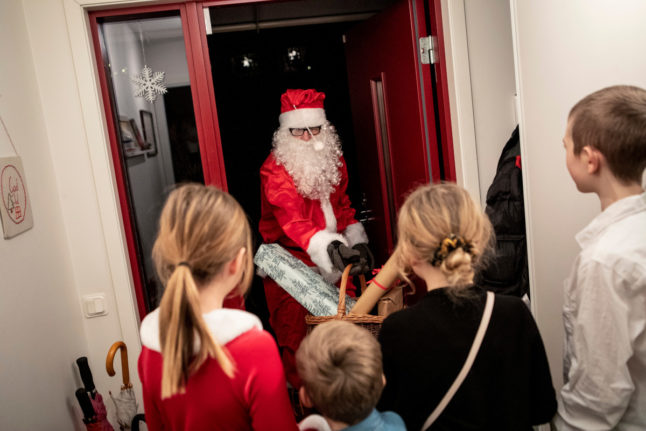Swedish Christmas is magical, but let’s face it – it’s also a bit odd.
You might find yourself wondering what the right greeting is for the time between Christmas and New Year, whether you misheard someone who mentioned a 20th day of Christmas, or why Swedes sing about Christmas gnomes while drinking snaps.
Here are some festive phrases to help you feel a bit more at home this Christmas.
The greetings | Hälsningarna
First, the basics. “Merry Christmas” is god jul while “Happy New Year” translates as gott nytt år.
Towards December 31st, you can also wish people a gott slut! This means “Happy end (of the year)”, though this is rarer and according to the late Swedish etiquette expert Magdalena Ribbing is better avoided, as the suggested finality might offend someone. Note that the “u” in slut is long, so it is pronounced like “sloot” rather than the English word “slut”.
Once the holidays are over, it’s common to wish people a God fortsättning! (Happy continuation [of the holiday season/year, depending on when you say it]).
- READ ALSO: Why I will always love Christmas in Sweden
Preparations | Julförberedelse
The Swedish Christmas season all starts with the first Sunday of Advent when the julbelysning (Christmas lights) get switched on and families start to get ready too, by preparing for Christmas (att julstöka), which includes pre-holiday cleaning (att julstäda), festive baking (att julbaka), and of course, decorating their homes for the holiday (att julpyssla).
Basically, adding the prefix jul- to ordinary tasks or objects instantly infuses them with some holiday spirit (julstämning).
The most common decorations are the adventsljusstake (Christmas advent candles, with one lit each Sunday in the lead-up to Christmas), and the adventsstjärna (Advent star – the star-shaped lights you’ll definitely have seen hanging in Swedish windows), not to be confused with the julstjärna (poinsettia, a must-have flower in Swedish homes each December).
In general the decorations are a bit less glittery (glittrig) and over the top (överdrivna) than some of those you’ll see in the UK or US.
You’ll need plenty of candles (ljus), a wreath (julkrans), possibly an angel chime (änglaspel), and hyacinth (hyacint). It’s also common to have decorations made from straw, as a reminder of the barn where Jesus was born; these might be straw wreaths, angels (änglar), or a Christmas goat (julbock).
Activities | Julaktiviteter
Though Sweden is largely secular, Christmas is one time of year when many families do go to church, perhaps for the Julnattsmässa (Midnight mass) on Christmas Eve or for the Julotta, the early morning service the following day.
Usually Christmas would include plenty of julfester (Christmas parties), and a julbord (Christmas buffet) or two.
Just like much of the rest of the world, Christmas in Sweden is a time for winding down (att koppla av) and relaxing with family and friends. You’ll hear a lot of things described as mysig, the equivalent of Danish hygge meaning cosy and comfortable, and the noun myskväll which describes a cosy night in, usually with family.
There’s plenty of TV to watch, and the evening of the 23rd, typically spent preparing for the next day’s festivities, is known as the uppesittarkväll (sitting-up evening), with several channels offering a Christmas special featuring music, competitions (including bingo), and celebrity guests. In southern Sweden, you’re more likely to hear this evening referred to as lillejulafton (Little Christmas Eve).
On Christmas Eve, Disney show Kalle Anka och hans vänner önskar God Jul (“Donald Duck and his friends wish you a Merry Christmas”) proves so popular year after year that up to 50 percent of the Swedish population sit down to watch it.
This has the weird result that at 3pm on Christmas Eve, when the show begins, there’s a significant drop in emergency calls and a spike in electricity usage as everyone settles in front of the TV, a phenomenon known as the Kalle Anka-effekt (Donald Duck effect).
There’s also a chance to get creative: traditionally, Swedes write short poems (julklappsrim or “Christmas present rhymes”) on their gift tags, which usually give a clue as to what the gift is.
Once Christmas is over, there’s the julgransplundring (Christmas tree plundering) to look forward to. Taking place on the 20th day of Christmas (Tjugondag Knut, St Knut’s Day on January 13th), it involves dancing around the tree before removing the Christmas decorations, smashing and eating gingerbread houses, as well as games and music. Finally, the tree is removed from the house; in the past, they were literally thrown out of windows, but these days you should take them to a designated area provided by local authorities.
READ ALSO: The idiot’s guide to the Swedish Christmas meal
Characters | Julfigurer
In Sweden, it’s the Jultomte who hands out Christmas gifts (julklappar); this is a figure who’s a cross between a traditional Swedish gnome (tomte) and Santa Claus. The image we have of him in Sweden today is largely based on illustrations Swedish artist Jenny Nyström did for a Christmas book in the 1880s, when she was asked to make the angry gnome slightly more likeable.
Traditionally, the jultomte will arrive and ask Finns det några snälla barn här? (Are there any nice children here?), to which the assembled family should reply in chorus Jaaaaa! – no matter what they’re really thinking.
But the jultomte can’t manage all the work on his own, and is helped out by tomtenissar (Christmas gnomes), the equivalent of Santa’s elves elsewhere, but more like miniature versions of the jultomte himself.
In the English-speaking world, reindeer are the animals most closely associated with Christmas, but in Sweden that’s not the case. Instead, the humble goat takes centre stage, with the tradition of the julbock (Christmas goat) dating back to pagan times. Originally, this was a spirit believed to watch over the festive celebrations, then the goat became the traditional gift-giver in the 19th century, before being replaced by the jultomte.
Songs | Julsånger
Swedes love a good Christmas tune, and a few that might resonate particularly with people far away from home are Jag kommer hem igen till jul (I’m coming home again for Christmas) and Hej mitt vinterland, which describes the joy of the wintery weather and Christmas in the air.
And don’t forget Raska fötter springa tripp, tripp, tripp (Brisk feet are running, click, click, click), a song which describes the Christmas goat (see above) on his way to deliver the festive presents.
Another key phrase to know is Hej tomtegubbar, slå i glasen. Och låt oss lustiga vara (Hey, Christmas gnome, fill up the glasses and let’s have fun!). This is part of a Swedish drinking song you’ll likely to hear at least once over the holiday season, accompanied with snaps.
READ ALSO: Ten Swedish Christmas hits for the festive season
Dates | Datum
Some say that the Christmas season starts when the first shops start selling julmust (a Christmassy spiced fizzy drink), but traditionally the season starts with the beginning of the advent season.
Advent is a big deal. As well as the candles and chocolate calendars you’ll see, there are other kinds of julkalender, including living advent calendars (levande julkalender) in several towns and cities, where each day a performance takes place in a window somewhere in town, and televised versions on several channels.
The Christmas celebrations include julafton (Christmas Eve), juldagen (Christmas Day), and annandag jul (second day of Christmas, or Boxing Day). To be more specific, there’s also dan före dopparedan (the day before dipping day, or December 23rd), and even dan före dan före dopparedan (the day before the day before dipping day).
The term “dipping day” for Christmas Eve comes from the old tradition of dipping a piece of bread in meat stock from a boiled ham, which used to be a common meal on the 24th and can still be found at some households.
The Swedes also have a term for that odd period between Christmas and New Year, usually spent unaware of what day of the week it is and passing the time eating the least popular chocolates left in the selection boxes: mellandagar (in-between days).
Swedish shops also start their sales then too: mellandagsrea. Other words that might come in useful around this time are bakfull/bakis (hungover), utsliten (frazzled) and sömndrucken (really sleepy).
Christmas proverbs | Julordspråk
Christmas as a foreigner typically means spending a lot of time with in-laws (svärföräldrar), making smalltalk at office parties (firmafester), and chatting to people you barely know at mulled wine parties (glöggfester – yes, they’re a thing in Sweden).
Swedes love to talk about the weather, and if you live in part of the country where the winter’s been a relatively mild so far, you could use the proverb Julasommar och fåglasång, påskavinter och släagång (“Christmas summer and birdsong, Easter winter and harsh weather” – basically, a mild winter means a cool spring and Easter) to impress your Swedish in-laws with your knowledge of the farmer’s almanac.
Article first written in December 2017 and last updated in December 2023.



 Please whitelist us to continue reading.
Please whitelist us to continue reading.
Member comments